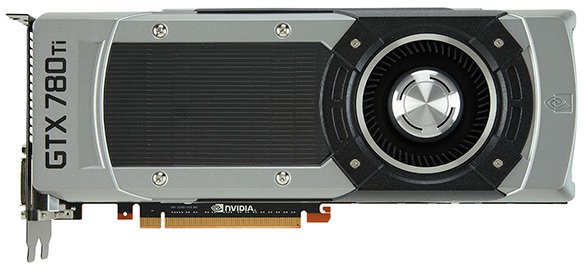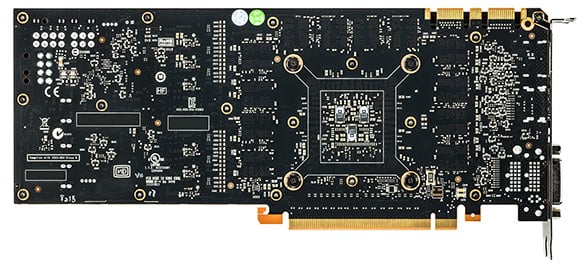NVIDIA GeForce GTX 780 Ti: Taking GK110 To The Max
Introduction and Specifications
Today’s launch of the NVIDIA GeForce GTX 780 Ti is somewhat satisfying to us on a couple of levels. First off, there are few things as exciting as a new, high-end GPU launch. We love checking out the latest and greatest processors, motherboards, and SSDs as much as the next geek, but there’s something inherently exciting about graphics that really gets our juices flowing. The second reason is a bit more egotistical.
While out at AMD’s tech days in Hawaii, a number of folks were chit-chatting about recent developments and some of our peers felt compelled to mention how “terrified” NVIDIA was of AMD's Hawaii GPU, that AMD caught NVIDIA off guard, and that they wouldn’t have any real answer until well into 2014. We sat back and listened to all the chatter and wondered how these things could be said with such conviction. Quite frankly, it just didn’t make any sense to us. NVIDIA’s had the GK110 GPU that powers the GeForce GTX Titan, 780, and now the 780 Ti done for ages, and prior to today, the GPU’s full capabilities hadn’t been available on a consumer GPU. Remember, the GK110 used on the GTX Titan has one of its SMXes disabled.
Anyway, to think NVIDIA didn’t have something up their virtual sleeve seemed outlandish to us, and wouldn’t you know it, a couple of weeks removed from AMD’s launch and what do we have? A new flagship from NVIDIA that’s ready for action. Take a look...

Feast Your Eyes On The GeForce GTX 780 Ti
|
| Graphics Processing Clusters | 5 |
| Streaming Multiprocessors | 15 |
| CUDA Cores (single precision) | 2880 |
| CUDA Cores (double precision) | 960 |
| Texture Units | 240 |
| ROP Units | 48 |
| Base Clock | 875 MHz |
| Boost Clock | 928 MHz |
| Memory Clock (Data rate) | 7000 MHz |
| L2 Cache Size | 1536K |
| Total Video Memory | 3072MB GDDR5 |
| Memory Interface | 384-bit |
| Total Memory Bandwidth | 336 GB/s |
| Texture Filtering Rate (Bilinear) | 210 GigaTexels/sec |
| Fabrication Process | 28 nm |
| Transistor Count | 7.1 Billion |
| Connectors |
2 x Dual-Link DVI |
| Form Factor | Dual Slot |
| Power Connectors | One 8-pin and one 6-pin |
| Recommended Power Supply | 600 Watts |
| Thermal Design Power (TDP) | 250 Watts |
| Thermal Threshold | 95°C |
| Price | $699 MSRP: Find on Amazon when available |
The NVIDIA GeForce GTX 780 Ti’s specification tell a big part of the story. The card shares the same 3GB frame buffer of the original GeForce GTX 780, but it is clocked at a much higher speed. The Ti’s GK110 GPU also has all of its functional blocks enabled. If we had to boil things down to a single sentence, the GeForce GTX 780 Ti is a GeForce GTX 780 with faster memory, but with a GPU more powerful than the GTX Titan’s.


The GeForce GTX 780 Ti, Front and Back
The GeForce GTX 780 Ti full-featured GK100 GPU has a base clock of 875MHz and a Boost clock of 928MHz. Unlike the GK110 on the Titan, however, all of the GPU’s SMs (Streaming Multiprocessors) are enabled on the GTX 780 Ti, which brings the card’s CUDA core count to 2880, up from Titan’s 2688. The number of active texture units also increases from 224 on Titan to 240 on the GeForce GTX 780 Ti.
The GeForce GTX 780 Ti’s 3GB frame buffer—half the size of Titan’s 6GB--is clocked at a blisteringly fast 7000MHz (effective GDDR5 data rate) and the memory links to the GPU via a wide 384-bit interface. At those clocks, the GeForce GTX 780 Ti offers up a peak textured fillrate of 210 GTexels/s and 336 GB/s of memory bandwidth, which should place the GeForce GTX 780 Ti among the fastest single-GPU powered graphics cards available today.
Like the GeForce GTX Titan, the GeForce GTX 780 Ti is outfitted with a frame made of aluminum to add rigidity. And the card has a metal fan housing as well. The GeForce logo along the top edge of the card lights up like the Titan’s too, and the brightness can be controlled via software as well.
The actual cooling hardware on the GTX 780 Ti consists of a large vapor chamber with a densely packed, nickel-plated aluminum finstack, and a large, rear-mounted barrel-type fan with user-adjustable fan curves. Like the GeForce GTX Titan, the GTX 780 Ti also uses low-profile components on about the front 65% of the PCB around the GPU, and the card’s cooler has a flat, ducted baseplate for unobstructed airflow, which minimizes turbulence and helps quiet down and better cool the card.


The GeForce GTX 780 Ti's GPU, PCB and Outputs
There is a window cut into the fan shroud that shows off the finstack (under a sheet of Lexan), and due to the fan configuration, virtually all of the heat produced by the card is exhausted from a system. Cards with centrally mounted axial-type fans, expel some of the heated air from the system, but dump the rest back into the case.
As evidenced by the pair of SLI edge connectors at the top of the card, the GeForce GTX 780 supports up to 3-Way SLI, and because the TDP of the card is only 250 watts, single 8-pin and 6-pin supplemental PCI Express power feeds are all that are required to power the GTX 780 Ti. We should note, however, the that the 780 Ti now offers a new power balancing feature that allows to card to direct power from whichever feeds have headroom, when under load. The card receives power from three sources—the two supplemental PCIe feeds and the PCIe slot itself. Should one become overloaded when overclocking, available power can be utilized from one of the other feeds, if it’s available.
Outputs consist of a pair of dual-link DVI outputs, a full-sized DisplayPort output, and an HDMI connector. The GeForce GTX 780 should have more than enough muscle to push multiple displays simultaneously, and as such, it supports NVIDIA's 3D Vision Surround technology as well. Like the other members of the GeForce GTX 700 series, the 780 Ti is ready for NVIDIA’s G-Sync technology too.






